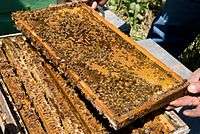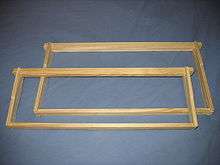Hive frame

A hive frame or honey frame is a structural element in a beehive that holds the honeycomb or brood comb within the hive enclosure or box. The hive frame is a key part of the modern movable-comb hive. It can be removed in order to inspect the bees for disease or to extract the excess honey.
History
In 1814 Petro Prokopovych invented the world's first beehive which used hive frames.[1] Early prototypes had a large distance between frames, and the frame lay on supporting strips of wood. As a result, the frames were cross-attached by burr comb and propolized to the supporting strips and were difficult to remove. In Prokopovych's design, the frames were placed only in the honey chamber. In the brood chamber, the bees built the combs in free style.
Jan Dzierzon described the correct distance between combs in the brood chamber as 1½ inches from the center of one bar to the center of the next. In 1848, Dzierzon introduced grooves into the hive's side walls replacing the strips of wood to hang top bars. The grooves were 8 mm apart and met the distance requirements for a bee space.
In May 1852, August von Berlepsch in Germany designed a movable frame. On October 5, 1852 in the United States, L. L. Langstroth patented a new hive with movable frames under US patent # US9300A. [2] Today, the Langstroth hive is the most common design.
Specifications

A Langstroth hive is designed to hold eight or ten frames (depending on the size of the box) spaced 1 1⁄2 inches (38 mm) center to center. The frames are made of wood or plastic. The top bar length is 19 inches (48 cm). The depth of the frame varies on the depth of the box:[3]
- Deep: 9 1⁄8 inches (230 mm)
- Medium: 6 1⁄4 inches (160 mm)
- Shallow: 5 3⁄8 inches (140 mm)[3]
The frame is made of:
- 1 top bar: It has two ears from which the frame hangs in the hive box. These are the only contact points with the box. These can be have a grove on the bottom in which the wax foundation or strips fits or an edge (usually made of wood) on which the bees attach the wax.[4][3]
- 2 side bars: It usually have three or four small holes used to attached the wax foundation.[3]
- 1 bottom bar: It usually has a grove in which the wax foundation sits in.[3]
Frames can be outfitted with wax foundation, starter strips or left empty for bees to build the entire comb from scratch.
Other Frames
.jpg)
- Plastic frames: They are injected-moulded out of plastic and come in various colors. They usually come with built in plastic foundation molded as one piece with cells stamped to a specific size. The colors usually are used to distinguish types of frames within a manufacture's product line (example: green for frames with drone size foundation cells).[5]
- Queen rearing frames: Specialty frames such as cell bar frames are used to raise new queens. The queen cups are attached vertically to bars to encourage bees to build queen cells. Once these cells are capped, the beekeeper moves them each to a queenless colony for adoption. [6]
- Drone Trap frames: Some beekeepers have designed frames specifically to encourage bees to built drone brood in order cut it out as part of an Integrated Pest Management (IPM) plan in the fight against Varroa destructor. [7]
See also
References
- ↑ Beekeeping in Ukraine - Petro Prokopovych - Petro Prokopovych
- ↑ US Patent # US9300A
- 1 2 3 4 5 Michigan Beekeepers' Association - In the Beekeeper's Work Shop - Building a Bee Hive: The Frames http://www.michiganbees.org/wp-content/uploads/2015/01/Frames_20140701.pdf
- ↑ Bush Farms - Foundationless - http://www.bushfarms.com/beesfoundationless.htm
- ↑ Acorn Bee - Plastic Frames - http://www.acornbee.com/plastic-frames/
- ↑ Queen Rearing Frame Plan - University of Minnesota - http://garybees.cfans.umn.edu/sites/g/files/pua2821/f/pcell_bar_frame.pdf
- ↑ Scientific Beekeeping - Fighting Varroa - http://scientificbeekeeping.com/fighting-varroa-biotechnical-tactics-ii/